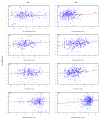Relationships among obesity, inflammation, and insulin resistance in African Americans and West Africans
- PMID: 19798069
- PMCID: PMC4151268
- DOI: 10.1038/oby.2009.322
Relationships among obesity, inflammation, and insulin resistance in African Americans and West Africans
Abstract
Several research studies in different populations indicate that inflammation may be the link between obesity and insulin resistance (IR). However, this relationship has not been adequately explored among African Americans, an ethnic group with disproportionately high rates of obesity and IR. In this study, we conducted a comparative study of the relationship among adiposity, inflammation, and IR in African Americans and West Africans, the ancestral source population for African Americans. The associations between obesity markers (BMI and waist-to-hip ratio (WHR)), inflammatory markers (high-sensitivity C-reactive protein (hsCRP), haptoglobin, interleukin (IL)-6, and tumor necrosis factor (TNF)-alpha), and IR (homeostasis model assessment of insulin resistance (HOMA(IR))) were evaluated in 247 West Africans and 315 African Americans. In average, African Americans were heavier than the West Africans (by an average of 1.6 BMI units for women and 3 BMI units for men). Plasma hsCRP, haptoglobin, and IL-6 (but not TNF-alpha level) were higher in African Americans than in West Africans. In both populations, BMI was associated with markers of inflammation and with HOMA(IR), and these associations remained significant after adjusting for sex and age. However, the pattern of associations between measured inflammatory markers and IR was different between the two groups. In West Africans, hsCRP was the only inflammatory marker associated with IR. In contrast, hsCRP, haptoglobin, and IL-6 were all associated with IR in African Americans. Interestingly, none of the associations between markers of inflammation and IR remained significant after adjusting for BMI. This finding suggests that in African Americans, the relationship between inflammatory markers and IR is mediated by adiposity.
Conflict of interest statement
The authors declared no conflict of interest
Figures

References
-
- WHO. Obesity and Overweight. Fact Sheet. 2006
-
- American Obesity Association. AOA Fact Sheets. 2002
-
- Weight-control Information Network (WIN) Statistics Related to Overweight and Obesity. Fact sheet. 2006
-
- Trayhurn P, Wood IS. Signaling role of adipose tissue: adipokines and inflammation in obesity. Biochem Soc Trans. 2005;33:1078–1081. - PubMed
-
- Fantuzzi G. Adipose tissue, adipokines, and inflammation. J Allergy Clin Immunol. 2005;115:911–9. quiz 920. - PubMed
Publication types
MeSH terms
Substances
Grants and funding
LinkOut - more resources
Full Text Sources
Medical
Research Materials

